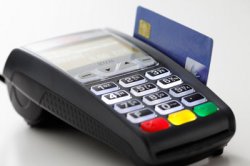Ingenico iCT220 reviews
 Gone are the days of credit card swipes being the common form of retail transactions. A credit card with a small computer chip called an “EMV” will begin its takeover Oct. 1, 2015, which also marks the shift in fraud liability on credit card charges.
Gone are the days of credit card swipes being the common form of retail transactions. A credit card with a small computer chip called an “EMV” will begin its takeover Oct. 1, 2015, which also marks the shift in fraud liability on credit card charges.
After years of success in Europe, the EMV cards are slowly becoming the norm in the U.S. The grocery store, local mall and even the tire dealer are slowly switching their standard credit card terminals to be EMV compatible, or must decide to do so before the liability shift.
EMV technology started in Europe in the 1980s and was formalized in 1994 by the three companies it’s named for – Europay, MasterCard and Visa. Today, EMV is overseen by EMVCo, which is equally owned and operated by American Express, Discover, MasterCard, JCB, UnionPay and Visa.
 The EMV card looks exactly like a regular credit card except for a metallic square chip located above the first four digits of the credit card number. This chip is a small microprocessor – a computer chip – that stores the card user’s data and security keys.
The EMV card looks exactly like a regular credit card except for a metallic square chip located above the first four digits of the credit card number. This chip is a small microprocessor – a computer chip – that stores the card user’s data and security keys.
In 2016, EMVCo reported 3.4 billion cards and 36.9 million terminals were in use around the globe, not including the U.S. As of December 2014, 3.4 billion EMV cards were in use, with 1.2 billion cards and 12 million EMV compatible terminals in the U.S.
EMV Security
The retail industry is trying to address two types of fraud by implementing the use of EMV chip cards, says Randy Vanderhoof, director of the EMV Migration Forum, an association created in 2012 to unite U.S. payment industry stakeholders facing the country’s move to EMV.
“One, is counterfeit card fraud where the account data that’s encoded on the magnetic stripe of plastic cards can be copied, or we call that ‘skimmed, ’ where the information can be stolen off of a card and then programmed onto a second card, creating a duplicate or counterfeit version of the first card, ” he says.





